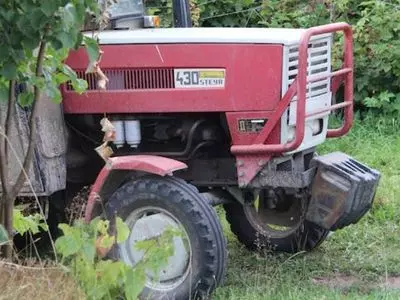No products in the cart.
Tractor
How to Check Hydraulic Fluid On a MAHINDRA Tractor
If you’re the owner of a Mahindra tractor, you know the importance of keeping your hydraulic fluid levels in check. Hydraulic fluid is what allows your tractor to function correctly, so it’s essential to make sure that it’s always at the correct level. This article will show you how to check hydraulic fluid on a Mahindra tractor and make any necessary adjustments!
*This post may have affiliate links, which means I may receive commissions if you choose to purchase through links I provide (at no extra cost to you). As an Amazon Associate I earn from qualifying purchases. Please read my disclaimer for additional details.
What is Hydraulic Fluid?

- Your tractor’s engine may overheat
- The moving parts within your engine and transmission will not move properly and efficiently
- You may not get as much power
- Your tractor may malfunction
How to Check Hydraulic Fluid On a Mahindra Tractor

- To check the fluid levels, start by removing the cap and pulling the dipstick out.
- Clean the dipstick with a cloth, reinsert it, and then pull it out again.
- The scale on the dipstick will indicate the current fluid level. If the level is low, add hydraulic fluid until it reaches the full mark.
- Check the owner’s manual for the correct hydraulic fluid type.
What to Do if the Hydraulic Fluid Level is Low
First, check for any leaks in the system. If there are no leaks, add hydraulic fluid to the reservoir. Make sure to use the correct type of fluid, as using the wrong type can damage the seals and other components in the system. Here’s a video showing how to fix a hydraulic fluid leak: Once you have added more fluid, recheck the level and ensure it’s between the minimum and maximum levels. If it’s still low, you may have a leak on one of the lines or fittings. In this case, it is best to take your tractor to a professional for service. With proper care and maintenance, Mahindra tractors will give you years of trouble-free service.How to Top off the Hydraulic Fluid
- Park your Mahindra tractor and turn off the engine.
- Raise the hood and locate the hydraulic fluid reservoir. The reservoir is usually located near the front of the engine and will have a fill plug and a dipstick.
- Remove the fill plug with a wrench and check the fluid level with the dipstick. If the fluid level is low, proceed to step 4. If the fluid level is at or above the FULL mark on the dipstick, skip to step 7.
- Slowly pour hydraulic fluid into the reservoir until it reaches the FULL mark on the dipstick.
- Replace the fill plug and tighten it with a wrench.
- Start the engine and allow it to run for a few minutes so the new fluid can circulate through the system.
- Recheck the fluid level with the dipstick to ensure it is still at or above the FULL mark. If it has dropped below that point, add more fluid until it reaches the correct level.
How to Dispose of Hydraulic Fluid

Re-Use
Re-use is the most environmentally friendly disposal method, but it is not always possible. If the hydraulic fluid is still in good condition, it can be filtered and reused. However, before reusing hydraulic fluid, it is essential to check with the manufacturer to ensure that it will not void the warranty on the equipment.Recycle
Recycling is the next best option for disposing of hydraulic fluid. The fluid can be sent to a recycling plant, which will be cleaned and used to create new hydraulic fluid.Incineration
Incineration is another option for disposing of hydraulic fluid. The fluid is burned at a high temperature, which destroys any harmful chemicals that may be present. However, this disposal method should only be used as a last resort, as it can release harmful pollutants into the air.Landfill
The final option for disposing of hydraulic fluid is landfill. This is the least preferred disposal method, as the fluid can leach into groundwater and contaminate soil and drinking water. If a landfill is the only option available, it is essential to prevent leakage by storing the fluid in double-walled containers or lining the storage area with impermeable materials.How to Prevent Hydraulic Fluid Leaks
- Check for leaks regularly and repair them promptly – it is much easier to fix a small leak than a large one.
- Use high-quality hydraulic fluid – cheap fluid is more likely to leak and cause problems.
- Keep the hydraulic system clean – dirt and debris can cause wear and tear, leading to leaks.
- Regularly inspect hoses and fittings – worn or damaged hoses can lead to hydraulic fluid leaks. Following these simple steps can help prevent hydraulic fluid leaks in your tractor.

